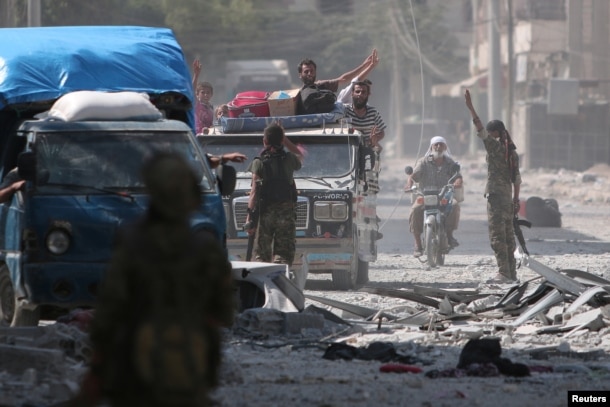Frayed IS Fighters Plot Strategy in Northern Syria

Sirwan Kajjo VOA NEWS
WASHINGTON — Pushed from their strategic stronghold of Manbij in northern Syria in recent days by U.S.-backed forces, retreating Islamic State fighters are scrambling over how and where to next make a stand.
Islamic State militants are becoming increasingly trapped in pockets along the Turkish border and are reportedly resorting to desperate measures, according to analysts and commanders of forces fighting Islamic State (IS).
After months of fighting for Manbij, held by IS for nearly two years, U.S.-backed Kurdish-Arab alliance forces are bent on pursuing IS in other pockets that remain under its control. Losing Manbij was a severe blow to the militants, according to the Pentagon and local commanders.

“Manbij was a central hub [for IS] for transporting foreign fighters and supplies from Turkey into its territories in Syria,” said Nasir Hajji Mansur, a military commander with the U.S.-backed Syrian Democratic Forces (SDF).
During the 73-day-long Manbij offensive, more than 4,000 IS fighters were killed, the SDF said Tuesday in a news conference from inside Manbij.
Mansur said it is now extremely difficult for IS fighters to move as freely to and from Turkey as they could when they were in control of Manbij.
Air campaign
Coupled with an ongoing airstrike campaign by the U.S.-led coalition, military advances made by local anti-IS forces have forced the militant group to be on the defensive on many front lines in Syria. IS fighters are likely to look for new frontiers in Syria where they can hold territory.
“The would-be caliphate will want to offset its losses in northern Syria with gains in places like Homs, Hama and Dara’a, where it is not subject to the same pressure,” said Nicholas A. Heras, a Middle East researcher at the Center for a New American Security.
IS recently stepped up its fight against Syrian President Bashar al-Assad’s forces in the eastern part of Homs province. Most of the coalition airstrikes against IS targets have been concentrating on north and eastern Syria.

FILE – Syria Democratic Forces (SDF) fighters greet civilians who were evacuated by the SDF from an Islamic State-controlled neighborhood of Manbij, in Aleppo Governorate, Syria, Aug. 12, 2016.
Recent IS territorial losses have contributed to the shrinking of Islamic State’s economy that is largely dependent on the dynamics of Syria’s civil war.
“The more territories they lose, the harder it gets for them to be effective in governance,” said Jowan Hemo, a Syrian economist who closely observes IS economic activities.
IS salaries reduced
Two days after it was defeated in Manbij, IS reduced salaries of its public servants in northern Syria by 50 percent and its fighters by 20 percent, local news reports said.
“Their economy is clearly deteriorating,” economist Hemo said. “International coalition’s airstrikes on (IS) oil facilities have reduced selling power by nearly 90 percent.”
While the militant group is on the defensive in parts of Syria, military leaders say IS will not be fully defeated unless it is ousted from its remaining major strongholds.
“Raqqa and Deir Ezzor are still in their hands,” Mansur said, referring to the major Syrian cities.
“[The control of] these cities brings them military confidence,” he told VOA in a phone interview.
The U.S.-led coalition has said the liberation of Manbij will help it move forward with its plan to retake Islamic State’s de-facto capital, Raqqa, in Syria.
“Manbij will inform us as to how we are going to fight in Raqqa,” U.S. Gen. Sean MacFarland said recently.
SDF commanders in recent days formed an “al-Bab Military Council,” with the aim of liberating al-Bab, an IS-held town about 32 kilometers west of Manbij.
“The [international] military coalition will continue to work with capable and motivated local forces to defeat [IS] and ensure it remains defeated,» U.S. Secretary of Defense Ash Carter said this week.
Terror attacks likely
To draw attention elsewhere and show its strength, IS will most likely try to increase its terror attacks outside Syria – especially in Turkey where it has had success in multiple attacks that have killed hundreds in recent months.
“[IS] will most likely carry out more suicide attacks now that its offensive capabilities are weakening,” Mansur said.
In the August issue of its Turkish-language magazine, Konstantiniyye, IS renewed its threats to the West, calling on its followers to carry out attacks in Europe and the United States.
“Know that your targeting civilian people is more pleasant and impressive to us,” said the magazine, enticing its supporters in the West to attack civilians.

